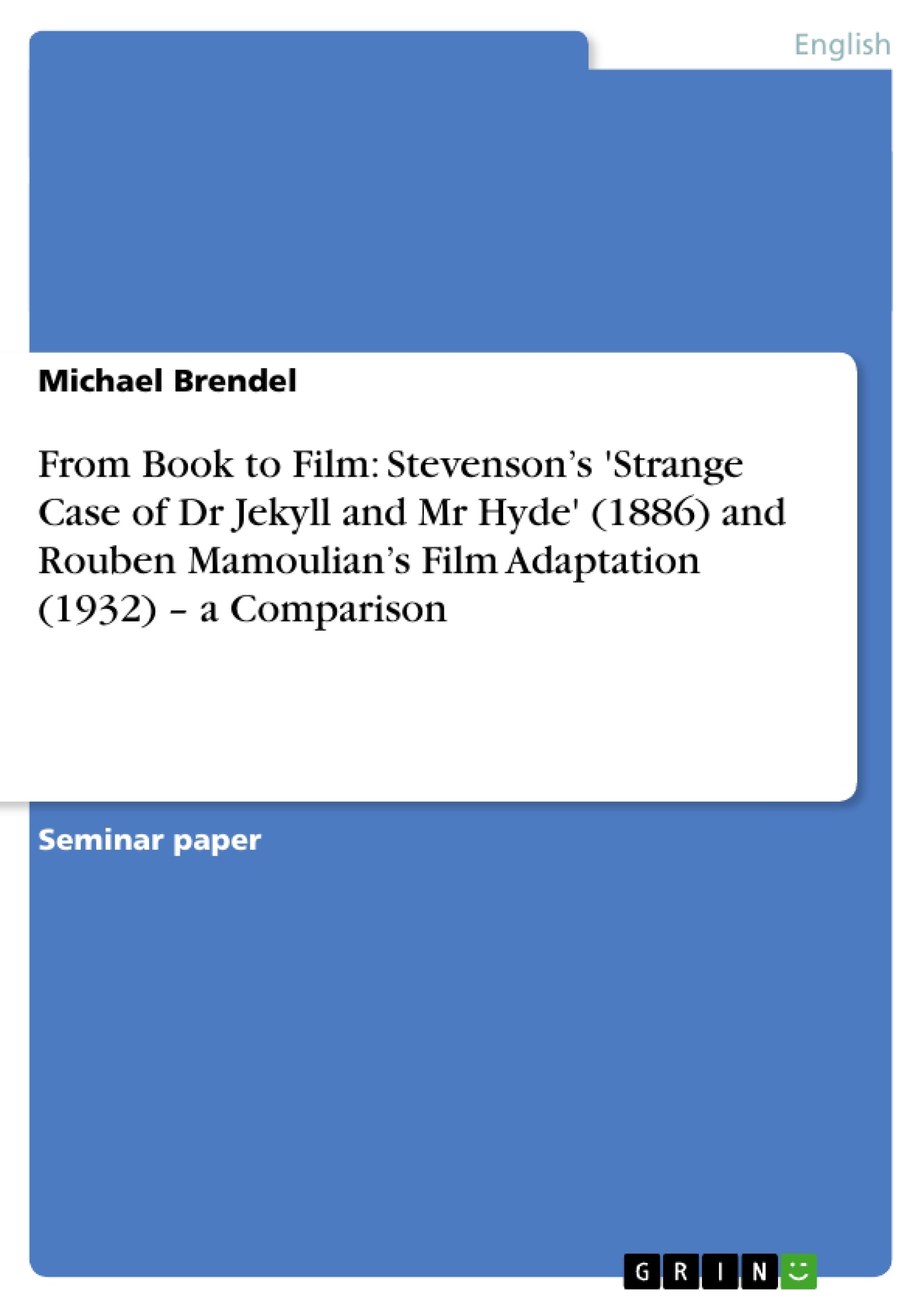On the following pages we will have a closer look at the process of film adaptation by analyzing Rouben Mamoulian’s Dr. Jekyll and Mr. Hyde (1932) – probably the most accomplished film version of Stevenson’s novella – and by comparing it with its literary model. At first, we will recapitulate the complexity of the source text, especially with regard to the question of genre. We will also examine T.R. Sullivan’s theatrical adaptation, which can in some respects be seen as a blueprint for Mamoulian’s film. Then, we will have a look at the literary macrostructure of the film at hand, discuss Mamoulian’s interpretation of Stevenson’s Strange Case and compare the source text with its screen adaptation from a narratological point of view. To finish our analysis, we will shed light on some techniques used by the director in order to communicate his ideas.
Inhaltsverzeichnis (Table of Contents)
- Introduction
- Main Part
- From Stevenson's Novella to Sullivan's Stage Adaptation
- Jekyll and Hyde as a Complex Mixture of Genres
- T.R. Sullivan's Adaptation of the Source Text
- Mamoulian's Film Adaptation of The Strange Case
- Changes in Literary Macrostructure: Plot and Character Constellation
- Mamoulian's Sexual Reading of Jekyll and Hyde
- Mamoulian's Darwinian Reading of Jekyll and Hyde
- Mamoulian's Adaptation from a Freudian Perspective
- Comparative Narratology
- Narrative Structure
- Narrative Perspective: Focalization and Ocularization
- Cinematic Devices
- Subjective Point-of-View-Shots
- Dissolves
- Split-screens
- Symbols
- From Stevenson's Novella to Sullivan's Stage Adaptation
- Synopsis
Zielsetzung und Themenschwerpunkte (Objectives and Key Themes)
This seminar paper aims to analyze the process of film adaptation by comparing Rouben Mamoulian's 1932 film adaptation of Robert Louis Stevenson's Strange Case of Dr Jekyll and Mr Hyde with its literary model. The paper will explore the complexity of the source text, examining its multiple genre elements and various interpretations, including the detective story, gothic novel, and allegory. Furthermore, it will analyze Mamoulian's interpretation of the source text, focusing on his reading of the story through a sexual, Darwinian, and Freudian lens. Finally, the paper will discuss the narrative structure and cinematic devices employed by Mamoulian to communicate his ideas.
- The multi-faceted nature of Strange Case of Dr Jekyll and Mr Hyde and its various interpretations
- The influence of genre on the adaptation process
- Mamoulian's adaptation of the source text and his unique interpretation of the story
- The use of cinematic devices to convey meaning and enhance the film's narrative
- The relationship between literary and cinematic adaptations
Zusammenfassung der Kapitel (Chapter Summaries)
- Introduction: This chapter introduces the concept of "tracer texts" and highlights the enduring popularity of Strange Case of Dr Jekyll and Mr Hyde, which has been adapted numerous times in various genres. The chapter also discusses the phenomenon of simplification in adaptations, particularly in film, and emphasizes the importance of understanding the source text for a successful adaptation.
- From Stevenson's Novella to Sullivan's Stage Adaptation: This chapter delves into the complexity of Stevenson's novella, identifying its various genre elements, including detective story, gothic novel, and allegory. It examines the different interpretations of Jekyll and Hyde, focusing on the moral, religious, and sexual readings of the story. The chapter also discusses the stage adaptation by T.R. Sullivan, which can be seen as a blueprint for Mamoulian's film.
- Mamoulian's Film Adaptation of The Strange Case: This chapter analyzes Mamoulian's film adaptation, focusing on the changes in literary macrostructure, plot, and character constellation. It explores Mamoulian's unique interpretations of the story, including his sexual, Darwinian, and Freudian readings. The chapter also discusses how these interpretations are reflected in the film's visual and narrative elements.
- Comparative Narratology: This chapter compares the narrative structure and perspective of the source text and the film adaptation. It discusses the different ways in which Stevenson and Mamoulian present the story and how these differences affect the audience's understanding of the characters and themes.
- Cinematic Devices: This chapter examines the cinematic devices employed by Mamoulian in his adaptation, focusing on subjective point-of-view shots, dissolves, split-screens, and symbols. It discusses how these devices contribute to the film's overall meaning and effectiveness.
Schlüsselwörter (Keywords)
This seminar paper focuses on the adaptation of Strange Case of Dr Jekyll and Mr Hyde, exploring the complex interplay of genre, interpretation, and cinematic techniques. Key themes include the nature of the double, the struggle between good and evil, the Victorian era, and the adaptation process. The paper also draws on concepts from narratology, film theory, and psychoanalysis to analyze the source text and its film adaptation.
- Arbeit zitieren
- Michael Brendel (Autor:in), 2010, From Book to Film: Stevenson’s 'Strange Case of Dr Jekyll and Mr Hyde' (1886) and Rouben Mamoulian’s Film Adaptation (1932) – a Comparison, München, GRIN Verlag, https://www.grin.com/document/150981
-

-

-

-
Laden Sie Ihre eigenen Arbeiten hoch! Geld verdienen und iPhone X gewinnen. -

-
Laden Sie Ihre eigenen Arbeiten hoch! Geld verdienen und iPhone X gewinnen. -

-
Laden Sie Ihre eigenen Arbeiten hoch! Geld verdienen und iPhone X gewinnen. -

-
Laden Sie Ihre eigenen Arbeiten hoch! Geld verdienen und iPhone X gewinnen. -

-
Laden Sie Ihre eigenen Arbeiten hoch! Geld verdienen und iPhone X gewinnen. -

-
Laden Sie Ihre eigenen Arbeiten hoch! Geld verdienen und iPhone X gewinnen. -

-
Laden Sie Ihre eigenen Arbeiten hoch! Geld verdienen und iPhone X gewinnen. -

-
Laden Sie Ihre eigenen Arbeiten hoch! Geld verdienen und iPhone X gewinnen.

